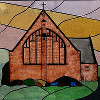Easter in Isolation
09 April 2020
With most people in the UK spending Easter indoors due to the Coronavirus COVID-19 pandemic, Alice Strang, Senior Curator of Modern and Contemporary Art, leads us from the Last Supper to the Resurrection by way of works in the National Galleries of Scotland’s collection.
Holy Week is the week from Palm Sunday to Easter Saturday. During it, Christians remember the events in Jesus’s life, from his triumphant arrival in Jerusalem to his Crucifixion and laying in a tomb. Easter Sunday marks his Resurrection from the dead. Art history is rich in examples of artists visualising these episodes.
John Bellany, Kinlochbervie
John Bellany was born in 1942 in the fishing village of Port Seton, near Edinburgh. He had a religious upbringing and much of his early work is rooted in his familiarity with the fishing community and its faith.
Bellany painted Kinlochbervie in 1966 whilst studying at the Royal College of Art in London. It is named after a fishing village in the north west of Scotland.The fish gutters lined up along the foreground of the work, before the spoils of the catch, refer to established iconography of Jesus and his disciples at the Last Supper – marked on Maundy Thursday of Holy Week. Moreover, the figure standing at the upper right carries a yoke across his chest in a visual reference to Jesus’s imminent Crucifixion on the following day, known as Good Friday.
Bellany thus transposed Biblical events to the present day, to show their lasting relevance whilst endowing the fishermen’s prosaic tasks with a religious dignitas.
Stanley Spencer, Christ Delivered to the People
Stanley Spencer is also renowned for his setting of Biblical scenes in a contemporary, autobiographical context. Born in Cookham, Berkshire in 1891, he studied at the Slade School of Fine Art in London.
Following Judas Iscariot’s betrayal of Jesus and his subsequent arrest, trial and sentencing by Pontius Pilate, Christ Delivered to the People of 1950 shows the start of the journey towards his crucifixion. Set in Cookham, Christ’s disciples are seen running away at the upper centre. The figure sitting on the steps to the leQ has been identified as Pilate, whilst the woman at the lower right is thought to be Spencer’s wife, the artist Patricia Preece, whom Spencer was trying to divorce at the time.
This highly personal account of the morning of Good Friday is full of betrayal and cowardice, rendered urgent by a sense of unstoppable movement.
Craigie Aitchison, Lily Still-Life
In contrast, Craigie Aitchison’s depiction of the crucifixion in his Lily Still-Life of 1974 is more subtle. Aitchinson was born in Edinburgh in 1926 and was the grandson of a United Free Church minister. Like Spencer, he studied at the Slade.
The focal point of this painting is a single lily, depicted in a delicately decorated vase. The lily is the traditional flower of Easter, symbolising Christ’s Resurrection. There is a suggestion that it is on a black window-sill in front of an orange wall. However, Aitchison combines flat planes of colour with a sense of distance, as a small cross is visible on top of a faraway hill.
The work can be read as a contemplation on the loneliness of Christ during his crucifixion, but with the emphasis on his re-birth on Easter Sunday.
Jacob Epstein, The Risen Christ
Jacob Epstein was born in New York City in 1880 and moved to London in 1905. His monumental The Risen Christ of 1917-1919 was cast in bronze and is 219cm tall. It shows Jesus standing and full- length, pointing with his left-hand to his raised right-hand, at the damage caused by being nailed to the cross.
The Bible relates how, following his death, Jesus was lain in a tomb whose entrance was covered by a stone. The following morning, marked on Easter Sunday, the stone was found to have been rolled away and Jesus had risen from the dead.
The Resurrection is the foundation of Christian doctrine and Epstein’s approach to it is based on gravitas rather than triumph. He began The Risen Christ in 1917, by making a mask capturing the spirituality and suffering of his ill friend, the composer Bernard van Dieren. Epstein then enlisted to fight in World War One, but was able to resume work on the sculpture a year later. He considered it an ‘anti-war statement’, relating the Allies’ bittersweet victory to that of Jesus’s over death. Epstein wished for it to be made on a vast scale as a ‘mighty symbolic warning to all lands’.
With churches and other places of worship currently closed due to the Coronavirus COVID-19 pandemic, Easter 2020 is bittersweet as well.
John Bellany: https://www.nationalgalleries.org/art-and-artists/400/kinlochbervie?search=the%2520last%2520supper&search_set_offset=47
Stanley Spencer: https://www.nationalgalleries.org/art-and-artists/868/christ-delivered-people
Craigie Aitchison: https://www.nationalgalleries.org/art-and-artists/383/lily-still-life
Jacob Epstein: https://www.nationalgalleries.org/art-and-artists/276/risen-christ
